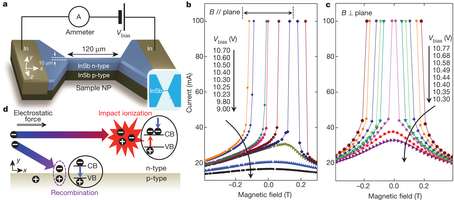January 31, 2013 report
Researchers build switchable magnetic logic gate

(Phys.org)—A team of scientists from several research centers in South Korea, has succeeded in building a logic circuit that is based on switchable magnetism, rather than electronics. They describe their research and a prototype they've built in a paper they've had published in the journal Nature.
Modern computers are based on transistors – electronic based circuits that use a small amount of electrical charge to create and hold one of two states – "on" or "off." This approach has allowed for the development of a wide variety of computing devices, but it also has its limits. The more logic gates a circuit has, the more electricity it requires, which means more heat buildup. It also means that circuits must be hard-wired, which limits the types of functions to which they can be put. Because of that, computers wind up having several types of dedicated circuit boards in them to carry out different applications, e.g. video, audio, CPU, etc. In this new research, the team from Korea has built a circuit that is based on switchable magnetism, and as a result, suffers from neither limitation.
To create the circuit, the researchers built a logic gate controlled by magnetism. In practice, it's a two layer bridge made out of the semiconducting material indium antimonide. The bottom layer has positively charged holes, while the top has mostly negatively charged electrons. Sending a magnetic field across the bridge in one direction causes the electrons to pass over the bridge and on through the circuit, sending it in the other direction causes the electrons to stop when they bump into the lower layer. The result is a logic gate that allows or disallows current to pass through – one state can be considered "on," the other "off" representing "1" or "0." And because the state of the logic gate is controlled by magnetism, it can be held in place in the absence of electricity. That means less heat and more importantly, an ability to program circuitry like software. A computer based on such logic gates would only need one circuit board – it could be reconfigured on the fly to carry out whatever purpose is needed, whenever that need comes about.
There are still some serious issues to be addressed, of course, before such circuits could be used in real applications however, such as how to integrate them with silicon based technology – and perhaps more importantly how to control thousands or even millions of tiny magnets in a practical way in a computing device.
More information: Magnetic-field-controlled reconfigurable semiconductor logic, Nature (2013) doi:10.1038/nature11817
Abstract
Logic devices based on magnetism show promise for increasing computational efficiency while decreasing consumed power. They offer zero quiescent power and yet combine novel functions such as programmable logic operation and non-volatile built-in memory. However, practical efforts to adapt a magnetic device to logic suffer from a low signal-to-noise ratio and other performance attributes that are not adequate for logic gates. Rather than exploiting magnetoresistive effects that result from spin-dependent transport of carriers, we have approached the development of a magnetic logic device in a different way: we use the phenomenon of large magnetoresistance found in non-magnetic semiconductors in high electric fields. Here we report a device showing a strong diode characteristic that is highly sensitive to both the sign and the magnitude of an external magnetic field, offering a reversible change between two different characteristic states by the application of a magnetic field. This feature results from magnetic control of carrier generation8 and recombination in an InSb p–n bilayer channel9. Simple circuits combining such elementary devices are fabricated and tested, and Boolean logic functions including AND, OR, NAND and NOR are performed. They are programmed dynamically by external electric or magnetic signals, demonstrating magnetic-field-controlled semiconductor reconfigurable logic at room temperature. This magnetic technology permits a new kind of spintronic device, characterized as a current switch rather than a voltage switch, and provides a simple and compact platform for non-volatile reconfigurable logic devices.
Journal information: Nature
© 2013 Phys.org



















